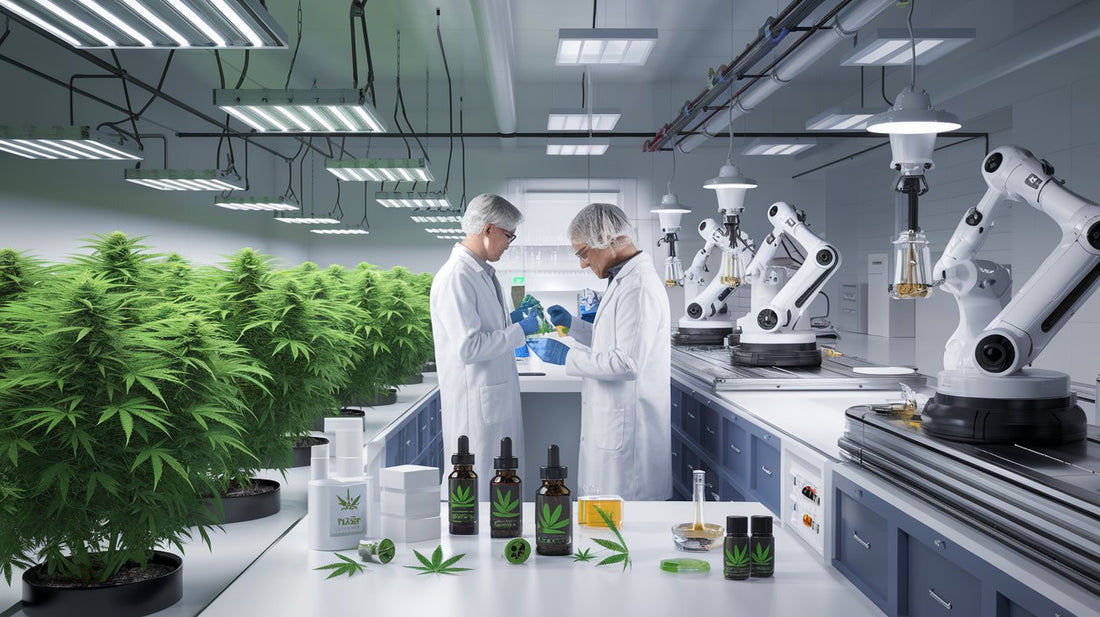
An Inside Look at the Cannabis Manufacturing Process: From Plant to Product
Share
Cannabis manufacturing is the backbone of the cannabis industry because it turns raw cannabis plants into the products we love. But what does this process entail?
In this blog, we will explore the fascinating stages of cannabis manufacturing! We will also provide you with the best tips on how and where to find reputable manufacturers to gain access to the highest-quality products on the market. So let’s dive in!
What is Cannabis Manufacturing?
Cannabis manufacturing is a process that involves transforming raw cannabis plants into a wide range of products through the extraction of cannabinoids like THC and CBD, which are then infused into tinctures, edibles, beverages, topicals, and more.
Furthermore, cannabis manufacturers are obliged to comply with the legal regulations set in place to ensure that the products are safe and effective. So they must prioritize quality control by performing rigorous testing on their products to ensure purity and potency.
However, they don't only focus on the extraction of cannabinoids and the quality of the products; they also specialize in preserving the plant’s aromatic terpenes and other beneficial compounds, which contribute to the product’s therapeutic benefits.
In addition, cannabis manufacturing facilities have specialized infrastructure that is integrated with advanced technology, further enhancing the efficiency of their production lines and allowing businesses to meet the growing demand for diverse products.
It’s no wonder why cannabis brands all over the world are opting to partner with cannabis manufacturers to improve their product quality and increase their bottom line. Now let’s take an inside look into the cannabis manufacturing process to understand the in’s-and-out’s.

The 8 Main Stages of Cannabis Manufacturing
Cannabis manufacturing is a complex and meticulous process that involves several steps. So, let's examine each stage to comprehend how our favorite cannabis products are available to us.
Cultivation
The first step is cultivation, where cannabis and hemp are grown in specialized environments with controllable temperatures, specific humidity levels, and advanced lighting systems to obtain the best quality of cannabis flowers, which can later be transformed into other products.
In this step of the process, professional growers select the strains, manage the conditions of the environment, like the amount of humidity or light the flowers are receiving, and ensure that the plants have the optimal soil and nutrients to create flowers that are pure and potent.
This stage of the manufacturing process typically lasts from 4 to 8 months. Once the strains have curled hairs and the terpenes are no longer transparent but rather milky white, the harvesting begins.

Harvesting
The harvesting process entails trimming the flowers or buds from the plant and disposing of the stems and leaves to avoid contaminating the final product. Growers use several harvesting techniques that yield different results. So let’s dive deeper into the main ones.
| Technique | Description | Pros | Cons |
| Hand Harvesting | The flowers are cut by hand using pruning shears. | It offers better control and minimal damage. | Labor-intensive and time-consiming. |
| Machine Harvesting | Automated machines trim and collect flowers. | It is fast and efficient for larg quantities. | It can cause damage to the trichomes. |
| Selective Harvesting | Mature flowers are picked at different times. | It provides optimized quality and reduced waste. | It requires frequent inspections and special care. |
| Whole Harvesting | The entire plant is cut and dried as a whole. | It ensures all parts of the plant are used. | It can mix mature with immature flowers. |
| Wet Trimming | The flowers are trimmed when still wet. | It is easier to cut and reduces mold risk. | It must be dried fast, to preserve quality. |
| Dry Trimming | The flowers are dried before trimming. | The slower drying preserves the terpenes. | The trimming is more difficult, delaying the process. |
Whichever method manufacturers select, this process is done under strict legal regulations to ensure that the flowers are handled with hygiene and care to avoid contaminated products from hitting the market.
Drying and Curing
Once the buds have been harvested, they undergo a drying and curing process, which is done to reduce the moisture in the flowers, avoid mold from forming, and ensure a high-quality product.
This also enhances the flavor, potency, and stability of the buds by ensuring that the cannabinoid profiles and terpenes are well preserved. The cured flowers are then transformed into multiple cannabis products through different extraction processes.

Extraction
The extraction process isolates cannabinoids like THC and CBD from the flowers to create other cannabis products. This can be achieved through several methods, so let’s take a deeper look to gain a better understanding of how they isolate these compounds.
| Method | Description | Pros | Cons |
| CO2 Extraction | It uses pressurized CO2 to extract cannabinoids and terpenes. | It’s non-toxic, and preserves the terpenes. | It’s complex and costly, due to the equipment. |
| Rosin Press | It uses heat and pressure to extract concentrated oil from the cannabis flowers. | It’s solvent-free while still retaining terpenes. | It provides a lower yield and can be time-consuming. |
| Ice Water Extraction | It uses iced water to separate the trichomes from the cannabis plant. | It creates a pure product with high terpene retention. | It is labor-intensive, and provides a lower yield. |
| Dry Sieve | The trichomes are separated by hand using fine screens. | It is very simple and solvent-free. | It’s less pure than other methods. |
| Ethanol Extraction | It uses ethanol to dissolve cannabinoids from the plant. | It’s efficient, providing a solvent good for tinctures. | It requires careful purging, given it can extract chlorophyll. |
| Hydrocarbon Extraction | It uses light hydrocarbons like butane or propane to dissolve the cannabinoids. | It provides high efficiency, producing potent extracts. | It is flammable and can leave solvent residues. |
As you can see, each method comes with its own pros and cons, so choosing the method will depend on the desired product. For example, while dry sieving is great for kief and moon rocks, rosin pressing is better for wax and vapes.
Refinement
Regardless of whichever extraction method is chosen, the extracts then need to undergo further refinement in order to achieve the desired levels of purity and potency, which can be done through several methods, including:
- Winterization, which is done by dissolving the extract in ethanol, freezing the solution at low temperatures, and filtering out any impurities before evaporating the ethanol.
- Short-path distillation, which uses heat to separate cannabinoids based on their different boiling points to achieve a high-purity isolate.
- Activated charcoal filtration, which is done by mixing the extract with activated charcoal that absorbs the unwanted colors and impurities.
- or recrystallization, which is done by dissolving cannabinoids in pentane and cooling the solution, crystilizing the cannabinoids and leaving the impurities in the solvent.
Keep in mind that these methods are often used in combination to achieve the desired purity level of the cannabis extracts, ensuring good test results and compliance with the legal standards regarding quality.

Formulation
Once the extracts have been refined, the formulation can begin. In this stage, the transformation of extracts is done by blending them with other ingredients to create various products, including oils, edibles, tinctures, topicals, and more.
Formulation not only helps manufacturers create consistent and efficient products; it also allows them to experiment with different ingredients to create innovative products that are catered to what specific audiences are asking for.
Testing and Quality Control
After the product has been extracted, refined, and formulated, it undergoes rigorous testing to ensure that it is free from contaminants, accurately labeled for cannabinoid content, and compliant with regulatory standards.

Packaging and Distribution
Finally, the finished products are packaged in secure, tamper-evident containers to preserve freshness and prevent contamination. These products are then distributed to dispensaries and other retail channels, making them available to consumers.
From plant to product, the cannabis manufacturing process facilitates high-quality products for brands everywhere, helping them reduce costs and increase their efficiency. So, if you’re looking to expand your product menu, let’s explore where to find a reliable manufacturer.

Where to Find Cannabis Manufacturers
As the cannabis industry continues to grow, numerous manufacturers operate worldwide, each specializing in different aspects of cannabis production. So, here are some of the best ways to find reliable cannabis manufacturers to fit your needs:
- Use platforms like Green Market Report, Weedmaps, and Leafly, which provide detailed information about manufacturers, including their services and product offerings.
- Attend industry events like MJBizCon, the Cannabis World Congress, and expos to network with manufacturers face-to-face.
- Ask at your local dispensaries, which often have relationships with nearby manufacturers, allowing them to provide recommendations.
- Join cannabis associations like the National Cannabis Industry Association (NCIA) to gain access to their member directories, where you can find reputable manufacturers.
- Ask your regulatory agencies, given that they oversee cannabis production and can tell you which manufacturers are compliant and legally operated.
By leveraging these resources, you can find reputable cannabis manufacturers that align with your needs and ensure access to high-quality cannabis products. However, let’s go through some tips on selecting a manufacturer so you can make the best decision.
Tips on Finding the Best Cannabis Manfucturers
Lastly, here are some tips to help you identify and select top-notch manufacturers:
- Check your manufacturer’s licenses to ensure they comply with local, state, and federal regulations.
- Look for manufacturers with a solid reputation in the industry by reading online reviews and testimonials and asking for proof of industry awards.
- Examine their certificates of analysis (COAs) to gain a better understanding of their levels of potency and purity.
- If possible, visit their production site or request a virtual tour to understand their operations better.
- Ask about the strains they use, their cultivation methods, and whether they use organic practices.
- Look for manufacturers with a proven track record and industry expertise.
- Assess their responsiveness, willingness to answer questions, and ability to provide detailed product information and support.
- If you have specific product requirements or formulations, find out if the manufacturer can accommodate custom orders.
- Review the contracts carefully to understand the pricing structure and ensure there are no hidden costs.
- Request references from other businesses or clients who have worked with the manufacturer and ask for samples to ensure that they are delivering what you need.
By following these tips, you can find a trustworthy and high-quality cannabis manufacturer that aligns with your needs and standards. So, what are you waiting for? Start looking today!

Conclusion
From cultivation to packaging, the journey of cannabis manufacturing is both complex and meticulous, ensuring the delivery of high-quality products that meet stringent regulatory standards.
This process not only underscores the importance of quality control and innovation but also highlights the collaborative efforts between cannabis brands and manufacturers to enhance product offerings and business outcomes.
Finding the right manufacturer is key to expanding your product line and ensuring excellence. So dive into this dynamic industry and discover how cannabis manufacturing can elevate your brand!
